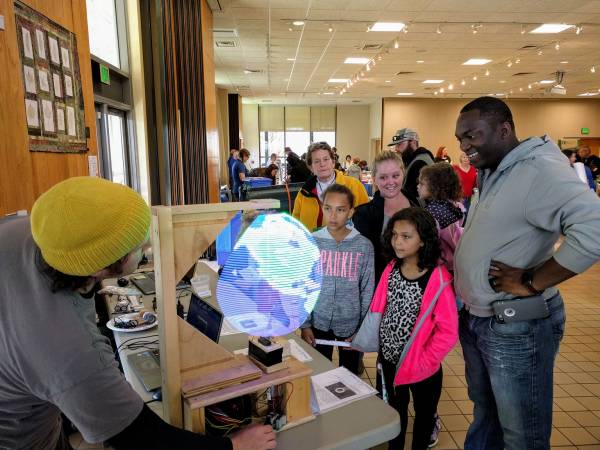The POV Globe project is mostly complete except for the never-ending tweeks that will no doubt keep happening for years to come (or until the globe breaks completely).
I got the idea from this article in Make: magazine, although my build ended up being quite different from theirs.
The first major change was the decision that 8 inches in diameter and 40 LEDs just wasn't going to cut it. I resisted the pressure to make it large enough for a person to ride inside of it and settled on a roughly 16“ diameter and 74 LEDs.
I cut a circular template on the CNC router and tried bending a piece of aluminum around this to create the circular frame, but I was unable to get anything satisfactorily close to a circle (and I wasn't just being picky - it was pretty bad). At that point (and why it took so long I can't say) it occurred to me that I could 3D print a near-perfect circle, and the lighter material would also be safer and easier on the motor. The print bed isn't large enough for a 16” diameter circle, but it was easy to design it in Fusion 360 to be in 4 sections with connectors holding the sections together.
I used an LED strip (neopixels are apparently not fast enough for a good POV display, so I used DotStar) instead of individual RGB leds and just glued it to the frame with contact cement.
I initially used a nano as the controller and an ESP8266-01 to give it WiFi capability, but Robert suggested I just use an ESP8266 Huzzah breakout board as the controller with built in WiFi. The built-in WiFi simplified the code considerably, and the faster speed (80 MHz vs 16 MHz) helped a lot as well. Robert even gave me one to use! Thanks, Robert! (and while I'm at it, thanks also to Avi for helping me understand how to write data to the LED strip without using a library - this really sped things up.)
The power supply is one we had at the space, salvaged from an old PC, and the motor controller was a cheap one ordered off of eBay. And, after many attempts at balancing the rotor with no armature holding the top stationary, I finally had to admit that a stabilizing arm was a necessity. The total cost of the globe was probably under $100 (but not by very much) with most of the expense coming from the LED strip and the motor. You could cut the cost considerably, I think, by using individual LEDs rather than a strip, but boy would you add a lot of work.
Once it was built, the next hurdle was being able to upload images on the fly. I wrote code in Python and using OpenCV that can take just about any image, resize it to fit on the globe (max 150 x 74 pixels), save it, and upload it to the globe. In addition, it can capture images from a camera and upload these. The Vance Elementary classes that came through the space really enjoyed having their pictures show up on the globe!
If anyone is interested in building one of these, I would be happy to share my files and advice from what I learned along way.
I have also set up the ThinkPad laptop that runs the RAMPS printer to control the globe. Please don't do this without checking with me first, but the steps to do this are:
- click the Start button and run the Anaconda Prompt
- within the prompt window, type 'activate POVGlobe' to open the correct Python environment
- if this worked, you should see <POVGlobe> prepended to the prompt
- type 'idle' to open a Python editor
- select File/Open and open \Documents\POV Globe\Python_Code_POV_Globe\POV_Globe\globe_control.py
- select Run/Run Module to start the program


